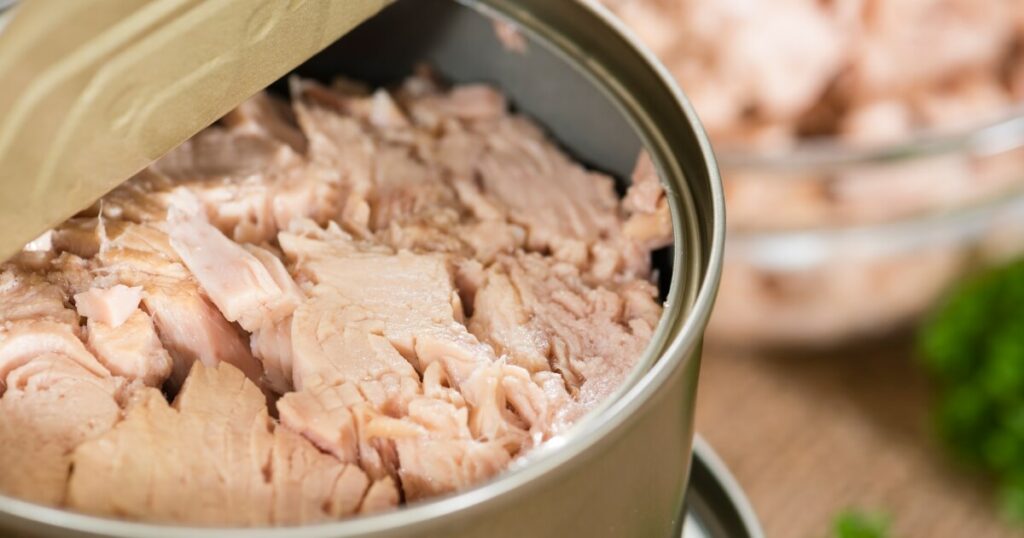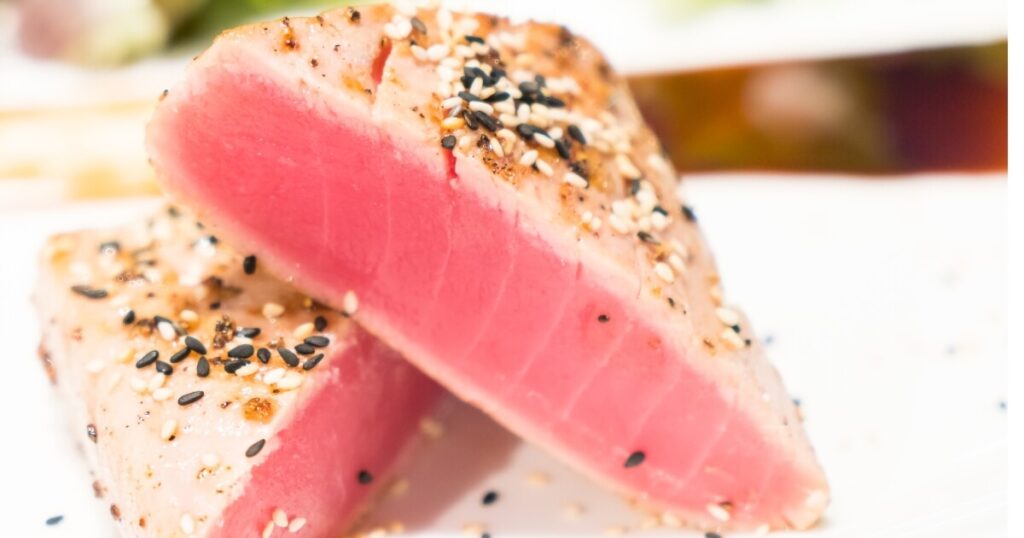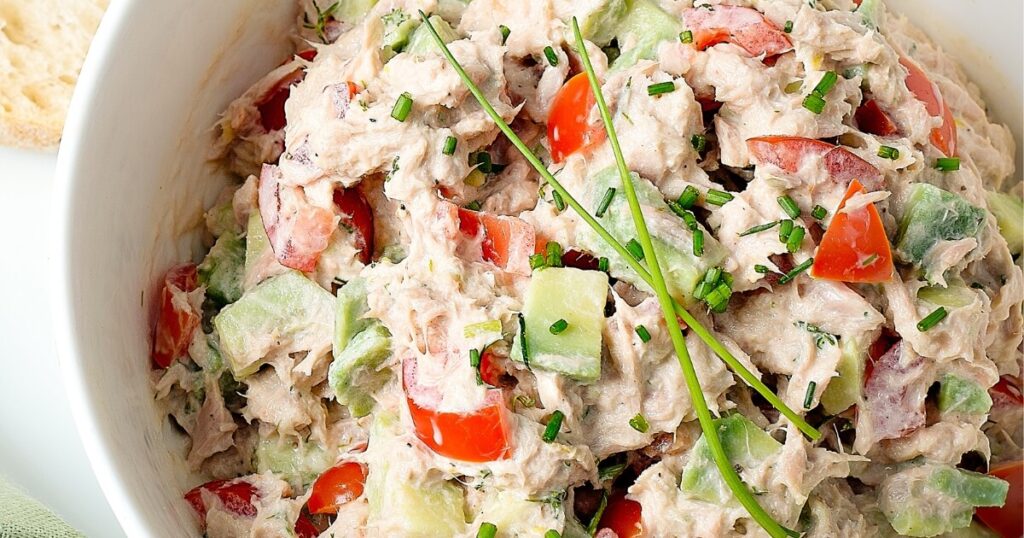Did you know that tuna is one of the most versatile fish in the culinary world? Its unique flavor profile has made it a favorite among food enthusiasts and home cooks.
Tuna’s taste offers a meaty and dense texture that melts in your mouth. It’s not overly fishy but has a taste that leans toward the flavors of a perfectly cooked steak.
This article will explore its taste, texture, and the different ways it can be prepared.
How Does Tuna Taste?
Imagine biting into a piece of tuna. You’ll first notice its meaty and dense texture, which is quite unlike most other fish. It’s firm yet tender and has a certain richness that fills your mouth with a delightful sensation.

Tuna has a flavor that’s both sweet and saline, a surprisingly pleasant and satisfying combination. It’s a subtle yet distinct taste, making it a versatile ingredient that can be used in various dishes.
Tuna doesn’t have the strong, fishy taste that you might expect from seafood. Instead, it’s more like a perfectly cooked piece of steak. This makes it a great choice for those new to eating fish or those who prefer milder flavors.
However, it’s worth noting that the taste can vary depending on the type of tuna. For instance, albacore tuna has a lighter flavor than bluefin tuna’s more robust taste.
When cooked, tuna’s flavor becomes even more pronounced, and the meaty texture becomes firmer. However, overcooked tuna can become dry and lose some of its flavor.
On the other hand, raw tuna, like what you’d find in sushi, has a softer texture and a more delicate flavor.
Varieties Of Tuna
There are several varieties of tuna:
- Bluefin Tuna: Known for its rich, buttery flavor, Bluefin is often considered the most luxurious variety of tuna. It’s commonly used in high-end sushi and sashimi.
- Yellowfin Tuna: Also known as Ahi, Yellowfin tuna has a mild, clean taste with a hint of sweetness. It’s firm and lean, making it perfect for grilling or searing.
- Albacore Tuna: Albacore has a lighter flavor and a softer texture than other varieties. It’s the most common type of tuna you’ll find in canned products.
- Skipjack Tuna: Skipjack has a stronger, more pronounced flavor than other types of tuna. It’s also commonly used in canned tuna products.
- Bigeye Tuna: Bigeye has a high-fat content, giving it a rich, silky taste. It’s used in sushi and sashimi.
What Does Tuna Compare With?
Tuna’s taste can be compared to a few other fishes:
- Salmon: Both tuna and salmon have a meaty texture but a stronger, more distinct flavor. Tuna is milder and leans more towards a sweet and salty taste.
- Chicken: Tuna is often called the ‘chicken of the sea’ due to its firm, meaty texture. However, its taste is more complex and nuanced than chicken.
- Steak: Tuna steaks, especially when seared or grilled, are very similar to beef steaks. The outside is slightly charred, while the inside remains tender and juicy.
- Swordfish: Swordfish and tuna have similar firm, meaty textures. However, swordfish has a milder flavor compared to tuna.
- Mahi Mahi: Mahi Mahi and tuna both have firm, dense textures and mild flavors. However, Mahi Mahi has a slightly sweeter taste.
Do Tuna Taste Fishy?
One of the most common questions people ask is whether it tastes fishy. The answer is not really.
The taste of tuna is a balance of sweet, saline, with a hint of umami. It’s a flavor profile that’s subtle yet satisfying.
So, if you’re someone who’s not a fan of fishy flavors, tuna might just be the fish for you.
However, it’s worth noting that the taste varies on the type of tuna and how it’s prepared.

For instance, canned tuna tends to have a stronger, more pronounced flavor than fresh tuna. But even then, the taste is more savory than fishy.
If you find your tuna to be a bit fishy, there are ways to mitigate this. One common method is to marinate the tuna in citrus juices, which can help neutralize any fishy flavors.
Another is to pair it with strong flavors like garlic, ginger, or soy sauce, which can complement and balance out the taste of the tuna.
Do Tuna Smell Fishy?
Just like its taste, the smell of tuna is not overly fishy. Fresh tuna should have a mild, clean scent that’s like the ocean.
However, the smell of tuna can become stronger and fishier if it’s not fresh. This is why it’s important to always choose fresh, high-quality tuna whenever possible.
The smell of tuna can also change depending on how it’s cooked. For instance, grilling or searing tuna can bring out a more savory, mouthwatering aroma. On the other hand, raw tuna, like what you’d find in sushi, has a more subtle, delicate scent.
What Do Tuna Look Like?
When you think of tuna, the first image that might come to mind is of a large, sleek fish gliding through the ocean. Tuna are impressive creatures with a body built for speed and endurance.

But what does tuna look like when it’s ready to be cooked and eaten?
In its whole form, a tuna is a large fish with a streamlined body, a pointed head, and a crescent-shaped tail. It has a dark blue back and a silver-white belly, a color scheme that helps it blend into its oceanic surroundings.
However, when you buy tuna from a market or a grocery store, you’re more likely to encounter it in the form of steaks or fillets.
Tuna steaks are thick, meaty cuts that resemble beef steaks in appearance.

They have a deep red or pink color, depending on the type of tuna. For instance, Bluefin tuna has a rich, dark red color, while Yellowfin tuna is lighter and more pinkish.
The color of the meat is a good indicator of the tuna’s flavor and texture, with darker meats generally having a richer taste and firmer texture.

When cooked, the color of the tuna changes. It turns from a vibrant red or pink to a light, creamy white, similar to the color of cooked chicken. However, if you’re preparing sushi or sashimi, the tuna retains its raw color, adding a beautiful pop of color to these dishes.
And let’s not forget about canned tuna. It’s usually light pink or white in color and has a flaky texture. While it may not look as appealing as fresh tuna, it’s a convenient ingredient to whip up sandwiches or salads.
How To Eat Tuna
Let’s explore some of the most popular ways to eat tuna.
Tuna Salad

Tuna salad is a classic dish that’s easy to make and flavorful. Canned tuna is mixed with mayonnaise, celery, onions, and seasonings, then served on bread or lettuce. It’s a light, refreshing meal that’s perfect for lunch or a quick snack.
Tuna Steaks
Tuna steaks are a popular choice for grilling or searing. They’re usually marinated in soy sauce, ginger, and other seasonings, then cooked until they’re slightly charred on the outside but still pink in the middle. The result is a flavorful, meaty dish that’s a healthier alternative to beef steaks.
Sushi and Sashimi
Raw tuna is a staple in sushi and sashimi. The mild, delicate flavor of the tuna pairs perfectly with the tangy rice and the sharpness of the wasabi.

In sashimi, thin slices of raw tuna are served with soy sauce for dipping. It’s a simple yet elegant dish that truly showcases the flavor of the tuna.
Tuna Pasta
Tuna is also a great addition to pasta dishes. It can be mixed with tomato sauce or cream sauce, then tossed with pasta for a quick and satisfying meal. The savory flavor of the tuna complements the pasta perfectly, making it a favorite among both kids and adults.
How To Make Tuna Taste Good
Tuna is a flavorful fish on its own, but there are several ways to enhance its taste and make it even more delicious:
Choose Fresh Tuna
The quality of the tuna you choose can greatly affect its taste. Fresh tuna has a clean, mild flavor far superior to older or lower-quality fish.
When buying tuna, look for bright, shiny skin and firm, springy flesh. The color should be vibrant pink or red, not brown or dull.
Use Marinades

Marinating tuna can enhance its flavor and add a new dimension to its taste. A simple marinade of soy sauce, ginger, garlic, and a touch of honey can give your tuna a savory, umami-rich flavor with a hint of sweetness.
Try marinating your tuna in olive oil, lemon juice, garlic, and fresh herbs for a Mediterranean twist.
Don’t Overcook It
Tuna is best when it’s cooked to medium-rare. Overcooking can make it dry and tough, which can diminish its flavor. If you’re grilling or searing tuna steaks, cook them on high heat for just a couple of minutes on each side.
Pair It With Complementary Flavors
Tuna pairs well with a variety of flavors. Try serving it with a tangy citrus salsa or a spicy wasabi sauce. Fresh herbs, like basil, cilantro, or dill, can also complement the taste of tuna.
For a simple yet flavorful side, try serving your tuna with a salad of mixed greens, cherry tomatoes, and a lemon vinaigrette.
Experiment With Different Cooking Methods
Tuna can be grilled, seared, baked, or even eaten raw. Each cooking method brings out a different aspect of the tuna’s flavor. Don’t be afraid to experiment and find the method that you like best.
How To Buy Tuna
Here are some tips to guide you when buying tuna:
Buying Fresh Tuna
When buying fresh tuna, there are several things to look out for. The color of the flesh should be a vibrant pink or red, not brown or dull.
It should also be shiny and moist, not dry or slimy. The flesh should be firm and spring back when you press it. If it leaves an indentation, the tuna is probably not fresh.
The smell of the tuna can also tell you a lot about its freshness. Fresh tuna should have a mild, clean scent that’s reminiscent of the ocean. If it smells overly fishy or unpleasant, it’s probably not fresh.
Buying Canned Tuna
Canned tuna is an affordable option that can be used in various dishes. When buying canned tuna, look for brands that use sustainable fishing methods.
The label should also indicate the type of tuna (such as albacore or skipjack) and whether it’s packed in water or oil. Tuna packed in oil tends to have a richer flavor, while tuna packed in water has a milder taste and fewer calories.
Buying Tuna at a Restaurant
When ordering tuna at a restaurant, don’t hesitate to ask questions. Find out where the tuna comes from and how it’s prepared.
Other Names for Tuna
Tuna can be found under several different names, depending on the type of tuna and where you’re shopping.
Some common types of tuna include Bluefin, Yellowfin (also known as Ahi), Albacore, and Skipjack. In sushi restaurants, you might see tuna referred to as “maguro” or “toro,” which refers to specific parts of the tuna.
Tuna FAQs
What does cooked tuna taste like?
Cooked tuna has a flavor that becomes even more pronounced. The sweetness and salinity become more balanced, and the meaty texture becomes firmer. However, it’s important not to overcook tuna as it can become dry and lose some of its flavor.
What does canned tuna taste like?
Canned tuna has a stronger, more pronounced flavor compared to fresh tuna. It’s also a bit drier in texture. However, it’s a versatile ingredient used in various dishes, from salads to sandwiches.
What does raw tuna taste like?
Raw tuna has a mild, delicate flavor and a soft, tender texture. It’s a bit sweeter than cooked tuna and perfect for sushi and sashimi.


